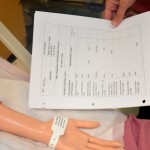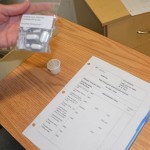6.2 Safe Medication Administration
In the Institute of Medicine’s often-cited book To Err Is Human: Building a Safer Health System (Kohn, Corrigan, & Donaldson, 2000), it is estimated that approximately 1.5-million preventable adverse drug events (ADEs) occur annually. The Joint Commission (TJC) defines medication errors as any preventable event that may cause inappropriate medication use or jeopardize patient safety (TJC, 2012).
Medication errors are the number-one error in health care (Centers for Disease Control [CDC], 2013). Safe and accurate medication administration is an important and potentially challenging nursing responsibility. Medication administration requires good decision-making skills and clinical judgment, and the nurse is responsible for ensuring full understanding of medication administration and its implications for patient safety.
Medication errors have a substantial impact on health care in Canada (Butt, 2010). When preparing and administering medication, and assessing patients after receiving medication, always follow agency policy to ensure safe practice. Review Table 6.1 for guidelines for safe medication administration.
Safety Considerations:
- Agency policy on medication administration and medication administration record (MAR) may vary. Always receive the required training on the use of the medication system for each agency to avoid preventable errors.
Principle
Additional Information
Technological Advances That Help Mitigate Medication Errors
Computerized physician order entry (CPOE) is a system that allows prescribers to electronically enter orders for medications, thus eliminating the need for written orders. CPOE increases the accuracy and legibility of medication orders; the potential for the integration of clinical decision support; and the optimization of prescriber, nurse, and pharmacist time (Agrawal, 2009). Decision support software integrated into a CPOE system can allow for the automatic checking of drug allergies, dosage indications, baseline laboratory results, and potential drug interactions. When a prescriber enters an order through CPOE, the information about the order will then transmit to the pharmacy and ultimately to the MAR.
The use of electronic bar codes on medication labels and packaging has the potential to improve patient safety in a number of ways. A patient’s MAR is entered into the hospital’s information system and encoded into the patient’s wristband, which is accessible to the nurse through a handheld device. When administering a medication, the nurse scans the patient’s medical record number on the wristband, and the bar code on the drug. The computer processes the scanned information, charts it, and updates the patient’s MAR record appropriately (Poon et al., 2010).
Automated medication dispensing systems (AMDS) provide electronic automated control of all medications, including narcotics. Each nurse accessing the system has a unique access code. The nurse will enter the patient’s name, the medication, the dosage, and the route of administration. The system will then open either the patient’s individual drawer or the narcotic drawer to dispense the specific medication. If the patient’s electronic health record is linked to the AMDS, the medication and the nurse who accessed the system will be linked to the patient’s electronic record.
Read the Top Ten Tips PDF to review the importance of medication reconciliation.
Checklist 43 outlines the steps for safe medication administration.
Disclaimer: Always review and follow your hospital policy regarding this specific skill.
Safety considerations:
- Plan medication administration to avoid disruption:
- Dispense medication in a quiet area.
- Avoid conversation with others.
- Follow agency’s no-interruption zone policy.
Steps
Additional Information
 Comparing physician orders and MAR" width="150" height="150" />
Comparing physician orders and MAR" width="150" height="150" />
Compare MAR with patient wristband.
- The right patient
- The right medication (drug)
- The right dose
- The right route
- The right time
- The right reason
- The right documentation
Medication calculation: D/H x S = A

The right medication (drug): check that you have the correct medication and that it is appropriate for the patient in the current context.
The right dose: check that the dose makes sense for the age, size, and condition of the patient. Different dosages may be indicated for different conditions.
The right route: check that the route is appropriate for the patient’s current condition.
The right time: adhere to the prescribed dose and schedule.

The right reason: check that the patient is receiving the medication for the appropriate reason.
The right documentation: always verify any unclear or inaccurate documentation prior to administering medications.
These checks are done before administering the medication to your patient.
- Position patient appropriately for medication administration.
- Ensure proper body mechanics for health care provider.
- Position patient safely and appropriately once medication is administered.
- Complete post assessment and/or vital signs (if applicable).
- Sign MAR; place in the appropriate chart.
- Perform hand hygiene.
This step prevents the transfer of microorganisms.
Critical Thinking Exercises
- Discuss why you think medication reconciliation is important for patient safety.
- List five steps you can take to ensure safe medication administration practice.
License
Clinical Procedures for Safer Patient Care Copyright © 2015 by Glynda Rees Doyle and Jodie Anita McCutcheon is licensed under a Creative Commons Attribution 4.0 International License, except where otherwise noted.

 Comparing physician orders and MAR" width="150" height="150" />
Comparing physician orders and MAR" width="150" height="150" />
